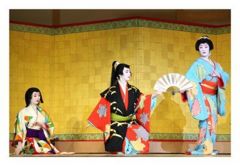Dance
 From Conservapedia - Reading time: 2 min
From Conservapedia - Reading time: 2 min
Dance is an art and is a form of movement, motions, and steps, usually done to music. Dance is also a way of communicating, and has been around since the beginning of time. Dance comes in many different forms and categories, such as Ballet, Modern, Jazz, Ballroom (including Waltz, Rumba, Salsa, Swing, Merengue, and Tango), Ethnic folk dancing (such as the Polka, Irish Dance, and Scottish Dance), Quadrille, Mazurka, Charleston, popular club dancing (such as Square Dancing, the Texas two-step, Country Western Dancing and breakdancing), and many more. Professional dancers are both athletes and artists. Music for dancing can be supplied by any kind of instrument, but generally each kind of dance is associated with a particular type of music.
Dance is a transient mode of expression, performed in a given form and style by the human body moving in space. Dance occurs through purposefully selected and controlled rhythmic movements; the resulting phenomenon is recognized as dance both by the performer and the observing members of a given group. Anthropologist Joann Kealiinohomoku.[1]
Ballet[edit]
Ballet is a specific dance form and technique. Works of dance choreographed using this technique are called ballets, and may include dance, music, acting and mime. [2] Ballet was first developed in the Renaissance in Italy and France, and later in Russia as a concert dance form. Classical ballet is the most formal of the different ballet styles. Ballet, as practised in Europe and the US, emphasizes the abstract geometry of bodily form exploring the heights and extensions the body can achieve both on the floor and in the air...
Dance in the Bible[edit]
Dancing is mentioned nearly two dozen times in the Bible; the word indicates joyful, exuberant celebration either toward God (as worship) or toward a conquering hero (like David). In contrast, dancing is frowned upon in many Muslim cultures, where Sharia law forbids it.
According to Mark 6:22-29 the dancing of Herodias' daughter before Herod and his companions was so pleasing to him that he offered the girl anything "up to half my kingdom". Coached by her mother, she asked for the head of John the Baptist.
Choreography[edit]
Choreography is the composition and arrangement of dances; the general art principles of design, like harmony, unity, variety, repetition, proportion, contrast, sequence, transition, balance and climax, must be used to create an aesthetic choreography. A ballet's choreography could be based on sources like: a story, a musical composition, or a painting.
- The scope of dance heritage is broad. Our heritage is the dance legacy that must be passed from generation to generation through educational dance. [3]
References[edit]
- ↑ Dance World of the Body.
- ↑ EzineArticles.com, Can You Appreciate the Art of Ballet?, by Jeffrey Meier http://ezinearticlesDOTcom/?Can-You-Appreciate-the-Art-of-Ballet?&id=294632
- ↑ Teaching Dance as Art in Education Autor Brenda Pugh McCutchen.
 KSF
KSF



